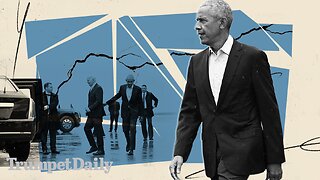Premium Only Content

Iranian and Jewish Cultures Have Been Connected For Millennia
The Jewish Virtual Library’s “Jews in Islamic Countries: Iran” reads:
The Jewish community of Persia, modern-day Iran, is one of the oldest in the Diaspora, and its historical roots reach back to the 6th century B.C.E., the time of the First Temple. Their history in the pre-Islamic period is intertwined with that of the Jews of neighboring Babylon. Cyrus, the first of the Archemid dynasty, conquered Babylon in 539 B.C.E. and permitted the Jewish exiles to return to the Land of Israel, bringing the First Exile to an end. The Jewish colonies were scattered from centers in Babylon to Persian provinces and cities such as Hamadan and Susa. The books of Esther, Ezra, Nehemiah, and Daniel give a favorable description of the relationship of the Jews to the court of the Achaemids at Susa.
Under the Sassanid dynasty (226-642 C.E.), the Jewish population in Persia grew considerably and spread throughout the region; nevertheless, Jews suffered intermittent oppression and persecution. The invasion by Arab Muslims in 642 C.E. terminated the independence of Persia, installed Islam as the state religion, and made a deep impact on the Jews by changing their sociopolitical status.
Throughout the 19th century, Jews were persecuted and discriminated against. Sometimes whole communities were forced to convert. During the 19th century, there was considerable immigration to the Land of Israel, and the Zionist movement spread throughout the community.
Under the Pahlavi Dynasty, established in 1925, the country was secularized and oriented toward the West. This greatly benefited the Jews, who were emancipated and played an important role in the economy and in cultural life. On the eve of the Islamic Revolution in 1979, 80,000 Jews lived in Iran. In the wake of the upheaval, tens of thousands of Jews, especially the wealthy, left the country, leaving behind vast amounts of property.
The Council of the Jewish Community, established after World War II, is the community’s representative body. The Jews also have a representative in parliament who is obligated by law to support Iranian foreign policy and its Anti-Zionist position.
Despite the official distinction between “Jews,” “Zionists,” and “Israel,” the most common accusation the Jews encounter is that of maintaining contacts with Zionists. The Jewish community does enjoy a measure of religious freedom but is faced with constant suspicion of cooperating with the Zionist state and with “imperialistic America” — both such activities are punishable by death. Jews who apply for a passport to travel abroad must do so in a special bureau and are immediately put under surveillance. The government does not generally allow all members of a family to travel abroad at the same time to prevent Jewish emigration. The Jews live under the status of dhimmi, with the restrictions imposed on religious minorities. Jewish leaders fear government reprisals if they draw attention to the official mistreatment of their community.
Iran’s official government-controlled media often issues anti-Semitic propaganda. A prime example is the government’s publishing of the Protocols of the Elders of Zion, a notorious Czarist forgery, in 1994 and 1999.2 Jews also suffer varying degrees of officially sanctioned discrimination, particularly in the areas of employment, education, and public accommodations.3
Following the overthrow of the Shah and the declaration of an Islamic state in 1979, Iran severed relations with Israel. The country has subsequently supported many of the Islamic terrorist organizations that target Jews and Israelis, particularly the Lebanon-based Hezbollah. Nevertheless, Iran’s Jewish community is the largest in the Middle East outside Israel.
After the Iranian revolution in early 1979, members of the Jewish community feared for their lives, afraid that they would be murdered or expelled by the new Iranian regime. After the execution of prominent Jewish businessman Habib Elghanian on May 9, 1979, was publicized in local news outlets, the leaders of the Jewish community in Iran knew that they had to act fast in order to guarantee the safety of all Iranian Jews. The community leaders quickly assembled a group of two rabbis and four prominent young intellectuals and set off to meet with Ayatollah Khomeini in the Iranian city of Qom. After the group congratulated the Ayatollah on his victory over the Shah in the recent revolution, the Ayatollah gave a long monologue concluding by comparing Christianity, Islam, and Judaism and saying that they are the only religions that are truly descended from heaven. The Ayatollah stated that in the Qur’an Moses’s name is mentioned more times than the name of any other prophet. The discussion concluded with Ayatollah Khomeini claiming that “we recognize our Jews as separate from those godless, bloodsucking Zionists.” This was the answer that the Jewish community leaders had been looking for, and the Iranian government has kept its word and kept the Jews physically safe (for the most part) ever since this moment.8
The Jewish Population in 1948 was 100,000 in 2023 it was 9,300
The Jews of Israel and the people of Iran continue to stand together against the terror that they are both facing.
-
 18:38
18:38
VSiNLive
2 days agoProfessional Gambler Steve Fezzik LOVES this UNDERVALUED Point Spread!
140K17 -
 LIVE
LIVE
Right Side Broadcasting Network
10 days agoLIVE REPLAY: President Donald J. Trump Keynotes TPUSA’s AmFest 2024 Conference - 12/22/24
2,828 watching -
 4:31
4:31
CoachTY
1 day ago $28.15 earnedCOINBASE AND DESCI !!!!
184K11 -
 10:02
10:02
MichaelBisping
1 day agoBISPING: "Was FURY ROBBED?!" | Oleksandr Usyk vs Tyson Fury 2 INSTANT REACTION
104K14 -
 8:08
8:08
Guns & Gadgets 2nd Amendment News
2 days ago16 States Join Forces To Sue Firearm Manufacturers Out of Business - 1st Target = GLOCK
126K91 -
 10:17
10:17
Dermatologist Dr. Dustin Portela
2 days ago $19.15 earnedOlay Cleansing Melts: Dermatologist's Honest Review
161K14 -
 1:02:20
1:02:20
Trumpet Daily
2 days ago $50.77 earnedObama’s Fake World Comes Crashing Down - Trumpet Daily | Dec. 20, 2024
116K71 -
 6:29
6:29
BIG NEM
1 day agoCultivating God Mode: Ancient Taoist NoFap Practices
83.8K21 -
 30:53
30:53
Uncommon Sense In Current Times
2 days ago $12.05 earned"Pardon or Peril? How Biden’s Clemency Actions Could Backfire"
93.9K10 -
 40:01
40:01
CarlCrusher
1 day agoSkinwalker Encounters in the Haunted Canyons of Magic Mesa - ep 4
85.5K10